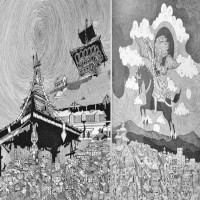‘Rapid infrastructure development poses threat to Kathmandu’s cultural identity’

By Renuka Dhakal
Kathmandu, Nov. 27: Art and culture reflect the identity of a country.
Nepal’s identity has also been interconnected with its original art, tradition and culture.
Nepal’s identity in the world is known as the country of Mount Everest as well as its distinctive religious and cultural practices.
Kathmandu, the capital of Nepal, is a place full of temples and cultural heritages. Nepal’s art, culture, and historical legacy have enhanced Nepal's self-esteem in the world.
Ironically, with the development and change many of our cultures and heritages are in the verge of extinction.
In a short span of time, the splendid temples, stupas, monasteries and many other original legacies are now hidden in dense urabn settlements.
In this backdrop, artist Sujan Dangol is exhibiting his art works reflecting the cultural identity of the Kathmandu Valley which, he said, is becoming ugly due to unmanaged urbanisation and rapid development.
He and other artists have displayed paintings, photography and grain art works at Siddhartha Art Gallery in Babarmahal. They have named the exhibition as ‘Tale of A City’.
As its title suggests, the ongoing art tells the story of Kathmandu which Dangol saw in his childhood.
His works have served to uplift the original tradition that has been going on for thousands of years in the Kathmandu Valley and has vividly portrayed the cultural encroachment in the name of modernity.
He said that he was born and brought up in Kathmandu, seeing the beauty of various traditional cultures, shrines and stupas, but lamented that the real beauty of the place is now being lost due to the skyscrapers and the modern construction.
Although he is not against development, he is disappointed that Nepal is losing its true identity due to rapid transformation in the name of progress.
The exhibition features photographs by Jagdish Upadhyay, Abhishek Shah, Anil Ranjit, Ashesh Dangol and Rupesh Man Singh.
Similarly, along with artist Dangol’s paintings, Sharmila Shrestha's grain art is also kept in the exhibition.
Artist Dangol has portrayed religion, culture, heritage and cultural splendor of the Kathmandu Valley through line drawings.
Architectural and archeological heritage issues are prominent in his paintings.
“I am now 40 years old. When we were young, Kathmandu used to have pagoda style houses. There were no tall houses. Many temples, monasteries and ‘Pati Pauwa’ used to fascinate the visitors,” said Dangol.
He added that the extent to which urban development is taking place now does not match our language, neither religion, caste and culture.
“The modern infrastructure would ease our life but with that we are losing our identity.”
Change is a law of nature, but rapid change in the name of modernity always threatens to destroy originality, artist Dangol said.
“It takes 500-1000 years to become a city. To say a city means to develop its language, culture and heritage at the same time. The way urban development has taken place in the last 20-30 years, it is creating a very difficult situation for us,” added.
The exhibition will last till November 29.
Recent News

Do not make expressions casting dout on election: EC
14 Apr, 2022
CM Bhatta says may New Year 2079 BS inspire positive thinking
14 Apr, 2022
Three new cases, 44 recoveries in 24 hours
14 Apr, 2022
689 climbers of 84 teams so far acquire permits for climbing various peaks this spring season
14 Apr, 2022
How the rising cost of living crisis is impacting Nepal
14 Apr, 2022
US military confirms an interstellar meteor collided with Earth
14 Apr, 2022
Valneva Covid vaccine approved for use in UK
14 Apr, 2022
Chair Prachanda highlights need of unity among Maoist, Communist forces
14 Apr, 2022
Ranbir Kapoor and Alia Bhatt: Bollywood toasts star couple on wedding
14 Apr, 2022
President Bhandari confers decorations (Photo Feature)
14 Apr, 2022











